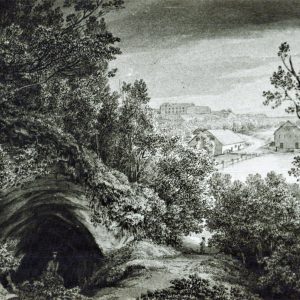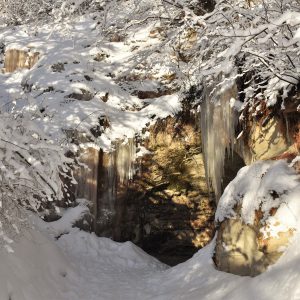Rauna Devil’s Cave
Rauna Devil’s Cave is approximately 50 m2 large and 13.6 cm deep subterranean cave in the white sand of Devonian sedimentary rock. The measurements of the cave were performed in summer 1974. Parts of the cave have been collapsed several times and afterwards the cave has been cleaned again. The last collapse occurred in late 70s – early 80s of the 20th century, when the cave was filled up for longer than 20 years. It was cleaned only in 2004 thanks to the activities of local residents and businesses. Several springs are originating above the cave, which develop beautiful icefalls in front of the cave in winter.
A legend about the development of the Devil’s Cave goes that, in ancient times, an old and rich devil lived in the vicinity of Rauna and his riches could be neither measured nor counted. Initially, he hid his money and gold in the hell itself, but young devils found it. Then he hid his riches in the forest, but the children of the earth found it, while picking berries and mushrooms. He finally decided that a secure hiding place must be made and dug a large and strong cave in the white rock. He took the earth that he dug out over the river and placed into a big hill, which resulted in the development of Tanīsa hill. The devil lived happily for hundreds of years until once, in spring, the Rauna river was flooded and water started to enter the cave. The devil took all his riches and went away to another, unknown place.
Gallery
Travel objects
- Rauna Castle
- Rauna Castle Courtyard
- Rauna Park and Rauna Manor Estate
- Rauna Evangelic Lutheran Church
- Rauna Agricultural Society House
- Rauna Freedom Monument
- Rauna Mill
- Strads Pub / Rauna Dairy
- Plūme House / Bookshop
- Rauna Parish House
- Rauna Congregation School / Office of Sarkanais Oktobris Collective Farm
- Rauna Devil’s Cave
- Rauna Staburags (Staburags Cliff of Rauna)
- Jānis Cimze Monument
- Rauna “Pārupe” (Left Bank)
- Baižkalns Manor Estate
- Lauktehnika (Agricultural Equipment Station)
- House of Doctor’s Skaidrais Family / House of psychotherapist Jānis Zālītis
- Rauna Hospital
- Rauna Post Office
- Rauna Pastor’s Manor
- The Centre of Rauna and the visit of USSR leader Nikita Khrushchev
- Rauna Cemetery
- Cemetery of Soviet Soldiers, who Died during the World War II
- Rauna Castle Tower
- Intermediate Passages of Rauna Castle
- Rauna Castle Plastering
- Heating and Smoke Channels of Rauna Castle







